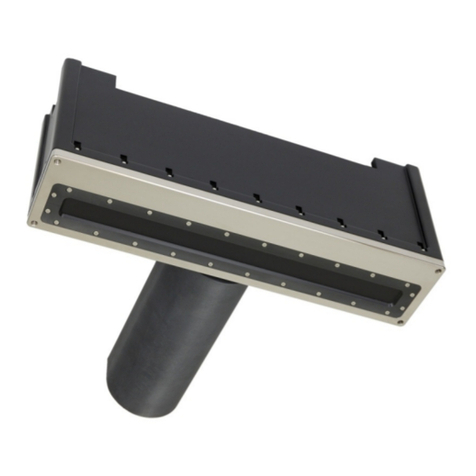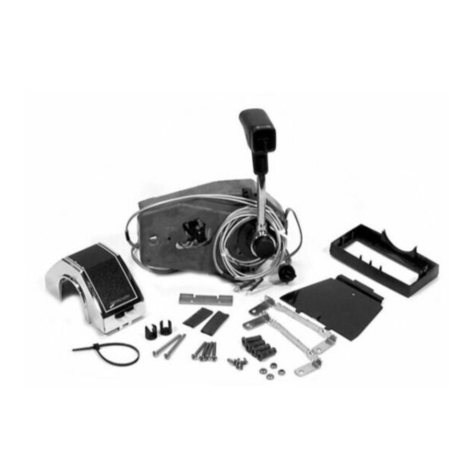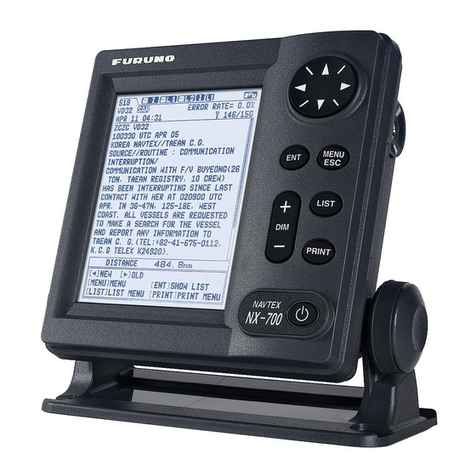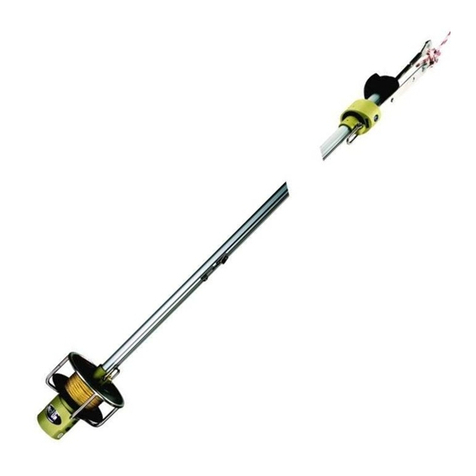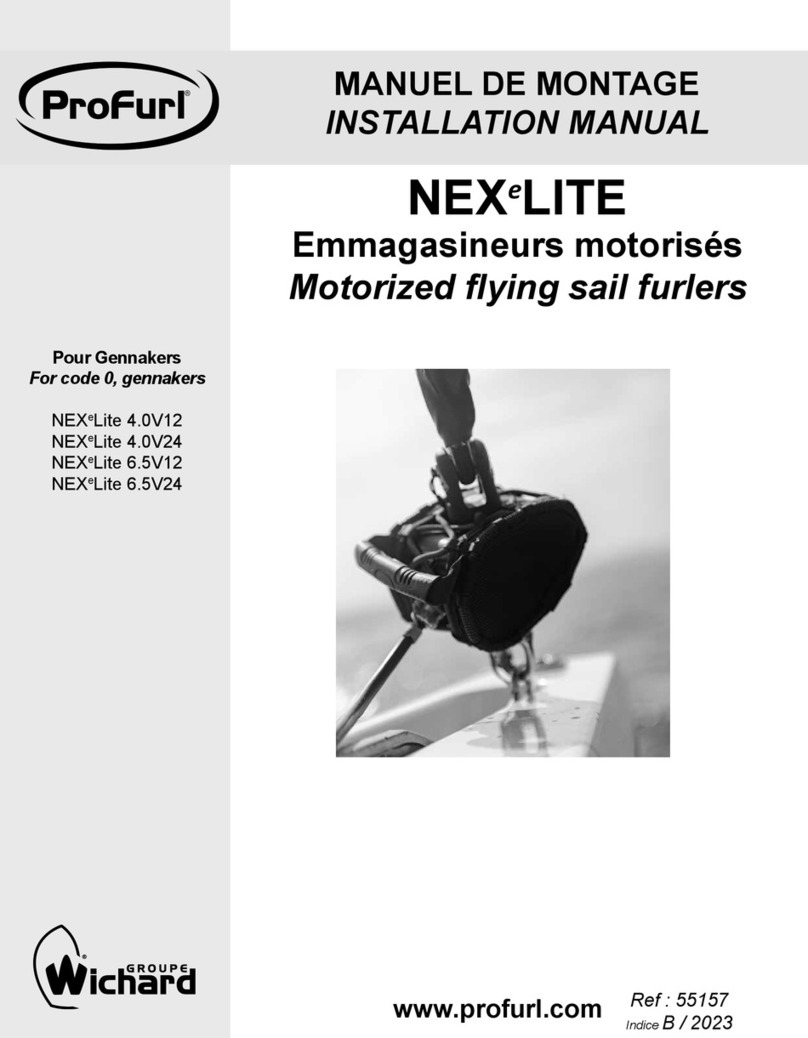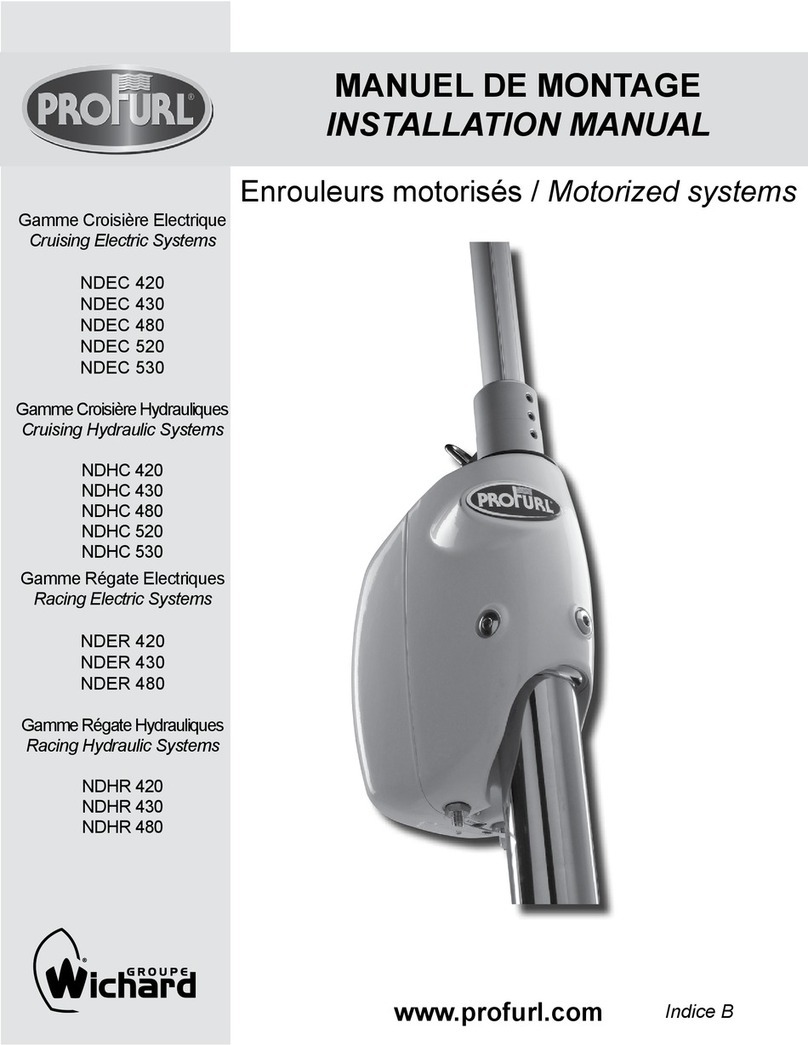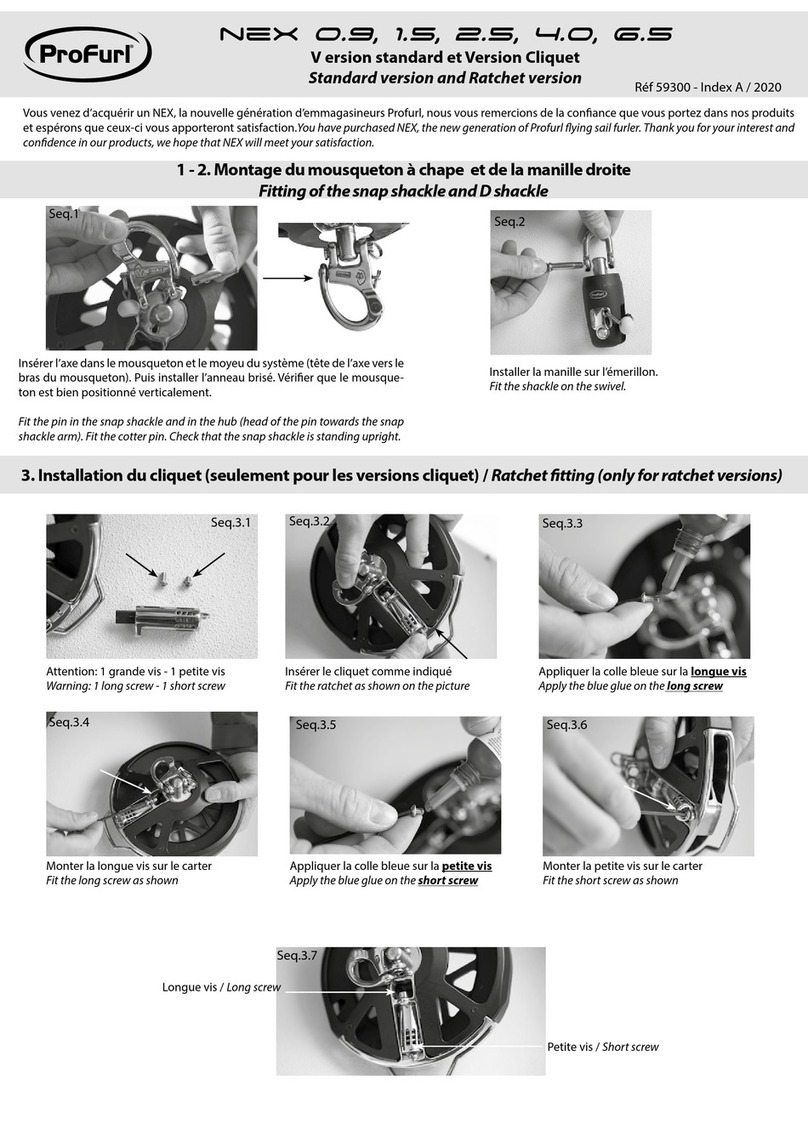RÉCEPTION DU MATÉRIEL
Le matériel voyage toujours aux risques et périls du
destinataire.Il y a donc lieu d’effectuer une vérication
dès réception, et émettre éventuellement toutes réserves
pour exercer le cas échéant tous recours à l’encontre des
transporteurs dans les délais réglementaires.
RECEIPT OF GOODS
All goods must be checked on delivery and the purchaser
should claim from the carrier within seven days in the event
of loss or damage.
I Précautions Préliminaires
I a) L’enrouleur PROFURL C260 est destiné à des monocoques.
Il n’est ni conçu pour multicoques, ni pour être utilisé pour une
trinquette.
I b) Il appartient à l’installateur de vérier ou de faire vérier par
une personne compétente que l’étai sur lequel l’enrouleur sera
installé est en bon état. En cas de doute, remplacer l’étai.
II Outillage nécessaire pour le montage
L’enrouleur de génois C260 a été conçu pour être installé
facilement. Pour son montage, quelques outils nécessaires:
- un décamètre
- un mètre ou réglet
- un pied à coulisse
- un petit marteau
- une scie à métaux
- une queue à rat
Vous devez vous procurer un cordage tressé de
diamètre 6 mm, d’une longueur égale à 3 fois
la longueur du bateau + 2 mètres.
Ce cordage sera utilisé à la fois en tant
que drisse et drosse d’enroulement.
III Principe de montage
Quelque soit la terminaison d’étai, le principe de montage reste
toujours le même:
La bride (7) est toujours serré en haut du sertissage inférieur. Si
le diamètre du sertissage inférieur de l’étai excede 9 mm, serrer la
bride à fond et la repercer en se guidant sur le trou existant à Ø
- 1mm.
Le C260 n’est pas conçu pour être monté sur une terminaison
inférieure d’étai type Norsemann®, Sta-Lok® ou équivalent.
Si il est nécessaire de recourir à ce type de terminaison, prévoir
une terminaison sertie en bas de l’étai et monter l’embout type
Norseman®, Sta-Lok® ou équivalent en tête de l’étai.
ATTENTION ! Lorsque le C260 est monté sur un étai
comportant un ridoir, celui-ci devra être vérrouillé avec des moyens
appropriés pour qu’il ne puisse en aucun cas être entraîné en
rotation lors de l’utilisation de l’enrouleur.
IV Identification des gaines de C260
L’enrouleur C260 comprend:
- 1 gaine inférieure longueur 0.50 m (14)
- 3 gaines de longueur de 2 mètres (17) si l’enrouleur a été livré en
6.50 m, ou
- 4 gaines de longueur de 2 mètres (17) si l’enrouleur a été livré en
8.50 m.
I Preliminary cautions
I a) The PROFURLC260 is designed for light displacement monohulls.
It is not designed to be used on multihulls, or for a staysail.
I b) If the age of your forestay exceeds seven years, replacement
may be necessary. If in doubt replace the stay.
II Tools needed for installation
The PROFURL C260 is designed to be easily tted. The following
tools are required for the installation:
- a measuring tape
- a measuring ruler
- a callipers gauge
- a small hammer
- a metal saw
- a round le
Please purchase a braided line with a 6 mm (1/4‘‘) diameter with a
length equal to three times
the boat length + 2 meters / 6 ft.
The line will be used for both halyard and furling line.
III Fitting principle
The principle to attach the drum onto the stay is always the same,
whichever type of lower terminal is found at the bottom of the stay
(eye or turnbuckle):
The clamp (7) is always attached onto the lower swage terminal (not
the forestay wire), and should be as close as possible from the upper
end of the lower swage terminal. Should the diameter of the swage
terminal exceeds 9 mm / 3/8’’ please tighten the screws to close the
clamp and drill at Ø minus 1mm / 1/16’’ through the existing hole.
The C260 is not designed to be tted over a Norsemann®, Sta-Lok®
or similar type of lower terminal. Should such a terminal be used,
please have a swage terminal at the bottom end the stay, and use
the Norseman®, Sta-Lok® or similar at the upper end of the stay.
CAUTION ! When the PROFURL C260 is to be fitted on to a
forestay with a turnbuckle, please make sure the turnbuckle is
properly and safely locked so that it can not turn when operating the
system.
IV Checking the C260 extrusions
The PROFURL C260 includes:
- 1 lower extrusion (14) 0.50 m / 1’ 7 43/64’’ long
- 3 extrusions, each 2 meter / 6’ 6 3/4’’ long (17) if the system has
been delivered in 6.50 meter / 21’ 3 3/4’’ total length or
- 4 extrusions, each 2 meter / 6’ 6 3/4’’ long (17) if the system had
been delivered in 8.50 meter / 27’ 10 ‘‘ total length.



